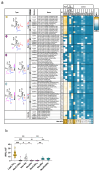Broad-Spectrum Legionaminic Acid-Specific Antibodies in Pooled Human IgGs Revealed by Glycan Microarrays with Chemoenzymatically Synthesized Nonulosonosides
- PMID: 39203058
- PMCID: PMC11356810
- DOI: 10.3390/molecules29163980
Broad-Spectrum Legionaminic Acid-Specific Antibodies in Pooled Human IgGs Revealed by Glycan Microarrays with Chemoenzymatically Synthesized Nonulosonosides
Abstract
The presence and the level of antibodies in human sera against bacterial glycans are indications of prior encounters with similar antigens and/or the bacteria that express them by the immune system. An increasing number of pathogenic bacteria that cause human diseases have been shown to express polysaccharides containing a bacterial nonulosonic acid called 5,7-di-N-acetyllegionaminic acid (Leg5,7Ac2). To investigate the immune recognition of Leg5,7Ac2, which is critical for the fight against bacterial infections, a highly effective chemoenzymatic synthon strategy was applied to construct a library of α2-3/6-linked Leg5,7Ac2-glycans via their diazido-derivatives (Leg5,7diN3-glycans) formed by efficient one-pot three-enzyme (OP3E) synthetic systems from a diazido-derivative of a six-carbon monosaccharide precursor. Glycan microarray studies using this synthetic library of a Leg5,7Ac2-capped collection of diverse underlying glycan carriers and their matched sialoside counterparts revealed specific recognition of Leg5,7Ac2 by human IgG antibodies pooled from thousands of healthy donors (IVIG), suggesting prior human encounters with Leg5,7Ac2-expressing pathogenic bacteria at the population level. These biologically relevant Leg5,7Ac2-glycans and their immune recognition assays are important tools to begin elucidating their biological roles, particularly in the context of infection and host-pathogen interactions.
Keywords: bacterial nonulosonic acid; carbohydrate; chemoenzymatic synthesis; human antibodies; legionaminic acid.
Conflict of interest statement
The authors declare no conflicts of interest.
Figures





References
MeSH terms
Substances
Grants and funding
LinkOut - more resources
Full Text Sources

